ON THIS PAGE
- Introduction
- Fear Circuitry
- Seeking Circuitry
- Satisfaction Circuitry
- Embodiment Circuitry
- Default Mode Circuitry
- Executive Circuitry
- Keys to Understanding Our Suffering, Healing and Happiness
Introduction
The brain can be understood, in part, as consisting of many different and interconnected circuitries.
(‘Circuitry’ simply means a collection of brain areas that work together to perform certain functions.)
After more than two decades of study and reflecting on what’s been most useful to those I teach (mostly therapists, police officers, attorneys, military commanders and higher education administrators), I have come to focus on a small number of key brain circuitries.
Keys to understanding your brain, your experience and your life
The circuitries that I focus on here are among the most studied in neuroscience. For each circuitry, thousands of studies have been conducted and published by many different research laboratories around the world. (There are still disagreements about some details, of course, and respected researchers disagree about what names or labels we should put on certain circuitries, but most of us need not worry about those things.)
I focus on these particular circuitries for a few important reasons. First, unlike many other aspects of brain function, the activities of these circuitries are (at least partly) accessible to conscious awareness. Second, because we can become aware of their functioning, we can exercise substantial choice over how we use these circuitries in our lives. And third, familiarity with these circuitries provides an essential foundation for understanding – and harnessing – basic brain and psychological processes that can bring either suffering or healing and genuine happiness.
For those who want the scientific research backing up my teachings on these circuitries, one place to start is a book chapter of mine that has citations to key research and a full references section. (Those citations are not comprehensive and more research is continually being published.)
Those who know something about the brain, and perhaps are familiar with the work of Daniel Siegel on interpersonal neurobiology, will see that I don’t organize things according to the ‘triune’ model of brain stem, ‘limbic system’ and prefrontal cortex. There are other differences in my approach as well.
My key circuitries approach, while compatible with and complementary to those of Siegel and others, sheds unique light on brain-based experiences and processes that are fundamental to our suffering, healing and happiness.
I focus on six key brain circuitries, beginning with the circuitry of fear, which you have probably heard about before (at least one key structure, the amygdala).
Even more important, however, are the circuitries of seeking, satisfaction, and embodiment. Although you probably haven’t heard of them before, I hope you’ll give me a chance to explain why they’re absolutely essential circuitries for us to understand – and take responsibility for – especially when it comes to finding healing and genuine happiness.
Fear Circuitry
The brain’s fear circuitry includes the amygdala and other brain regions (e.g., hypothalamus and periaqueductal gray). This is one of the best-known and most-studied circuitries in neuroscience, and a major focus of research on psychological trauma and PTSD (areas of my expertise).
The fear circuitry triggers and implements extreme fear responses, but also less extreme avoidance responses associated with lesser fears, or just things that we (i.e., our brains) find aversive.
More extreme fear responses implemented by the fear circuitry include freezing, a racing heart, rapid breathing, fight or flight behaviors, or even paralysis and passing out. (I regularly teach about how the fear circuitry largely governs responses during sexual assault, for example, Why Many Rape Victims Don’t Fight or Yell and Neurobiology of Trauma & Sexual Assault.)
But the fear circuitry isn’t only for what scares or terrifies us. It’s triggered by anything we find unpleasant and want to avoid. Indeed, the most common method for studying the fear circuitry in animals uses relatively mild but aversive foot shocks, not terrifying or traumatic experiences, to evoke and study fear responses and their brain bases. Thus we can also understand this as the fear/aversion circuitry.
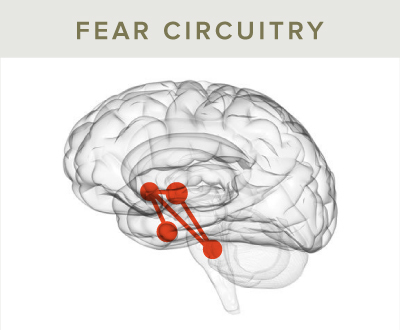
In fact, the fear circuitry is constantly on, at least idling to some extent, like a smoke detector always looking for signs of fire. Automatically and outside of our awareness, the fear circuitry constantly monitors the environment for signs of actual or potential threat, however large or small. This includes things that are linked in memory with bad past experiences (e.g., a harsh tone of voice, narrowed eyes), or simply things that are unfamiliar or unexpected.
Importantly, experiences that trigger the fear circuitry, unless they elicit a purely reflexive response, invariably recruit the brain’s seeking circuitry (described next). Our brains are constantly and automatically – within milliseconds – ‘tagging’ some experiences and things as unpleasant and unwanted, thus as experiences and things that we automatically seek to avoid and escape.
When feared and unwanted emotions like sadness, loneliness or shame get triggered (however much we notice them or not) our brains automatically seek escape from them, sometimes into addictive experiences. And for some people who have been hurt in important relationships, especially as children, even ‘positive’ experiences with other people, like being offered genuine affection, caring or love, can be unwanted and trigger fear and attempts to escape.
In short, our fear circuitry is always operating and continually influencing how we respond to unpleasant and unwanted experiences, however large or small. And, by repeatedly triggering the brain’s seeking circuitry, it is continually helping to determine which wants and hopes are driving our thoughts and behaviors.
Seeking Circuitry
Unlike the amygdala and the fear circuitry, you probably haven’t heard of the seeking circuitry, but it’s one of the most important circuitries in the brain. If it weren’t for this circuitry, we would not engage in any motivated behaviors.
The seeking circuitry is part of the brain’s ‘reward circuitry,’ which you may have heard of because, like the circuitry of fear, it is one of the most studied and best established circuitries in neuroscience (thanks to decades of research funded by the National Institute on Drug Abuse).
Most neuroscientists still just use the term ‘reward circuitry,’ even though it has subcomponents, including the seeking circuitry. But a few scientists have given names to this circuitry, based on their different views of brain functioning overall and of this circuitry’s roles in behavior and emotion. The name ‘seeking’ was coined by Jaak Panksepp, an influential neuroscientist who focused on (among other things) how animal and human brains are innately driven to engage with the world (not to ‘process information’).
Researchers have found that the seeking circuitry is what enables us to want and seek anything that involves effortful activity, whether conscious and deliberate effort, or automatic and habitual effort based on learning. It could be a drink of water or your next meal. It could be a new dress or shirt, a new pair of shoes or watch, or the latest technology toy. It could be an affectionate comment from a girlfriend, boyfriend, spouse or partner; praise from a co-worker or supervisor; or accomplishing a life goal. Or the next pain pill, drink of alcohol, hit of crack, or porn video.
As noted above, the seeking circuitry is what drives our attempts to avoid and escape from unwanted experiences that have activated the circuitry of fear and aversion. The unwanted experiences we seek to avoid and escape can be small, such as an annoying sound or an itch; bigger things, like a sharp pain in an injured knee or the feelings triggered by someone yelling at us; or really big things, like how it feels to be in a miserable marriage, or when someone you love is dying of cancer, being abused or unjustly jailed, or seeing a friend killed in war or on the street.
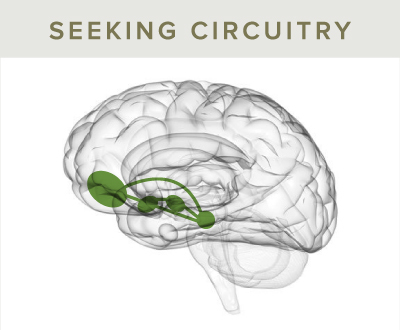
Because the seeking circuity is the brain circuitry that allows us to want and pursue anything that requires effort, it also allows us to long for and seek our most positive and healthy goals and needs. It allows our embodied minds (or souls) to experience and pursue our deepest personal and spiritual longings.
When we strive to fulfill our highest moral, religious and spiritual values and goals, this circuitry helps us do it. This does not mean that morality, religion and spirituality are ‘just brain processes.’ It only means that, as embodied beings with brains, whenever we long for and seek anything that requires effort, however noble and sublime, there’s a brain circuitry – this seeking circuitry – that biologically enables and implements our longing and seeking.
For people struggling with a great deal of suffering, their seeking circuitry can get overly focused on – even enslaved to – quick fixes. These fixes can be intoxicated states brought on by alcohol or drugs. They can be intoxicating sexual experiences, power trips, or sexual power trips.
Most importantly, a quick fix is any experience that is sought for immediate escape from suffering. As we can see in ourselves, in our family members, in our friends and co-workers, and in the daily parade of unhealthy and downright destructive ‘it seemed like a good idea at the time’ behaviors we see on TV and the internet, there’s no limit to what people will do to escape briefly from physical, emotional, and spiritual suffering.
Such quick fixes include minor unhealthy behaviors like eating or drinking too much, more problematic ones like lashing out at someone in anger to escape feelings of shame or powerlessness, and extreme self-harming behaviors like cutting or burning one’s body to reduce inner turmoil.
Quick fixes also include habitual ‘defense mechanisms’ like ruminating, mindlessly distracting ourselves with things on a screen or otherwise spacing out. Those habitual behaviors harm us less obviously, by disconnecting us from the potential fullness of our current experience (which can prevent us from responding to unwanted experiences in healthy ways).
The many ways we may ignore or deny what’s actually happening around and within us all can be understood as brief escapes or quick fixes that involve the seeking circuitry. Such escapes tend to be not only brief, but also addictive, and unfulfilling in any lasting way. Many cause more problems than they solve.
The seeking circuitry is also involved in the pleasures of expecting and pursuing what we want, and the excitement of both. For many people, this is the main or only kind of pleasure or happiness they know, that of anticipation. We all know some people for whom this is true. Maybe it describes you, if not now then at some time in your life.
But this ‘anticipatory pleasure’ of expecting and seeking is only one kind of pleasure, and not a particularly fulfilling one. It’s different from the pleasure of satisfaction that comes from getting what we’ve sought. As we all know, there’s a difference between the pleasure of anticipating eating a bowl of ice cream and the pleasure of actually eating it. The same is true of any addictive substance or behavior. (Some substances, however, including cocaine and methamphetamine, can be addictive precisely because they increase the pleasure of seeking itself.)
The seeking circuitry also shapes the activity of the ‘default mode circuitry.’ That’s the brain circuitry, described below, which underlies all those thoughts, daydreams, memories and plans that are constantly running through our heads – and often distracting us from what we’re trying to focus on.
When we step back and observe all that stuff running through our minds, we can’t help but see what they tend to revolve around: Seeking and experiencing imagined rewards – either of getting or keeping things we want, or, when fear drives our default-mode seeking, of escaping from things we don’t want or wish hadn’t already happened. That’s one reason that being ‘mindful’ is easier said than done. We’re constantly pulled into trains of thoughts and images about things we want and fear. (Researchers have found that the default mode activity of people experiencing negative emotions and depression are particularly dominated by fears and imagined escapes.)
Just as the amygdala plays a central role in the fear circuitry, the nucleus accumbens does in the seeking circuitry. Yet detailed knowledge of the brain areas that make up the seeking circuitry is not necessary to appreciate the central roles it plays in all of our lives.
In summary, the seeking circuitry is constantly active, often in response to the fear circuitry getting triggered. And it is constantly driving our thoughts, feelings, imaginings, and behaviors.
Indeed, the central role of seeking in human experience and behavior, and the importance of taking responsibility for what one seeks and focusing one’s seeking on what truly promotes human happiness and well-being, have long been pointed out by the world’s major philosophical and religious traditions. We simply cannot understand ourselves as individuals, families, communities and cultures – especially what brings us suffering and happiness – without investigating, with honesty and discipline, what our seeking circuitries are focused upon and why.
Satisfaction Circuitry
Just as important as the seeking circuitry is the satisfaction circuitry. That’s the name I’ve given to the other key component of the brain’s ‘reward circuitry.’
Extensive research has established that chemicals in the brain called opioids (and their receptors on brain cells) are centrally involved in feelings of satisfaction and contentment, as well as feelings of connection with others. As Panksepp and Biven have written, opioids acting on opioid receptors (specifically mu opioid receptors) not only take away feelings of pain but “send messages of pleasant satisfaction in the brain” (2012, p.25).
This opioid circuitry of satisfaction can give us the deeply fulfilling pleasures of feeling happy and loved. Any time we feel contented, this circuitry is involved. Whenever we feel comfort or joy. Such experiences, of course, are minimal or missing in the lives of people who are suffering greatly, including those struggling with major trauma, or major anxiety, depression and/or addiction. As noted above, sometimes the only feelings of pleasure that severely suffering people have are those of seeking, anticipating and experiencing substance-induced highs or other quick-fix escapes.
Again, it’s not necessary to know every brain chemical, brain region and receptor type involved in satisfaction and contentment (although there is substantial and growing research). But it is helpful to know that a central role in this circuitry is played by opioids. Many people have heard that opioids play a big role in experiences of pleasure and satisfaction – thanks to media reports on the high rates of addiction to opioid pain pills, heroin, and now fentanyl in many communities.

Like the brain’s own opiates, those from outside the body – whether injected as heroin or ingested via pain pills – act directly on this satisfaction circuitry. That’s why such opiate-induced highs involve intense (if short-lived) feelings of great comfort, well-being, joy, even bliss.
Embodiment Circuitry
Another extensively studied and well-established brain circuitry is what I call the embodiment circuitry. The more commonly used term in neuroscience is ‘interoceptive’ circuitry (interoception, broadly defined, refers to the process of receiving, accessing, and appraising signals originating within the body). Embodiment is a less technical term and clearly indicates that this circuitry allows us to know how it feels to be ‘in our bodies.’
A key part of the embodiment circuitry is the insular cortex or insula, a cortical region that brings together all information coming from the body (e.g., sensations of movement, touch, tension, pressure, warmth, etc.).
Information from the body includes unpleasant and unwanted sensations – like those of pain, fear, anxiety, sadness, or withdrawal from an addictive substance. Such body sensations trigger fear, aversion, and seeking (to escape).
Information from the body also includes pleasant and wanted sensations, including those associated with substance intoxication and behaviors that people find addicting. Such sensations, processed by the embodiment circuitry, can be strong drivers of craving, whether for addictive substances, food, or behaviors including gambling, shopping and sex. For example, researchers found that when people addicted to cigarettes suffered brain damage, damage to the insula was much more likely than damage to other brain areas to be followed by quitting smoking – suddenly, completely, and without even trying. Asked why, those with damage to this key part of the embodiment circuitry said things like, ‘My body forgot the urge to smoke.’
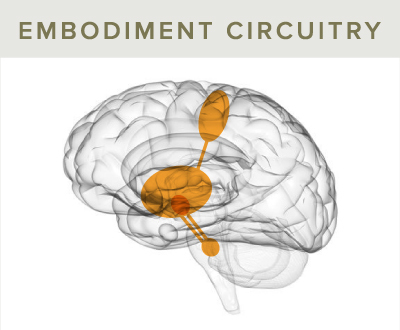
Awareness of the embodiment circuitry is important and helpful, because how we experience our bodies is an important dimension of our lives, and because different people have differing degrees of awareness of bodily sensations, including those that accompany emotions. For example, it’s not uncommon for traumatized people to suffer from emotional numbing and dissociation. Some say they have no idea what it’s like to feel an emotion in their bodies. And researchers (including my colleagues and I) have found that the less people feel emotions in their bodies, the less activity there is in insular cortex regions that are part of the embodiment circuitry.
The importance of the embodiment circuitry cannot be overestimated. Much of human suffering includes and is driven by unpleasant and unwanted body sensations. All addictions involve attempts, at least in part, to escape from unpleasant and unwanted bodily sensations and to embrace pleasant and wanted bodily sensations.
And all the truly good things in life include bodily sensations too (however aware of them we are). By ‘good things in life’ I’m not referring to luxury goods or the ‘pleasures of the senses’ (nor am I judging such things). I am referring to universally recognized goods that always promote well-being, including kindness, compassion, love, and peace. As discussed in Cycles of Suffering, Healing & Happiness, pleasant body sensations, especially of satisfying and loving experiences, can be powerful antidotes to fear and craving for escape.
Default Mode Circuitry
Another key brain circuitry that I focus on is the default mode circuitry. This too is an extremely well-studied circuitry, discovered by neuroscientists who were curious to see which brain areas were active when people were told – as they have been in thousands of experiments – to do ‘nothing’ while lying in a brain scanner.
When we are not focused on a particular task, our minds tend to wander. This wandering includes running through plans or scenarios in our heads, and imagining things we want to happen and do not want to happen.
Brain researchers call this the ‘default mode’ of the human brain, and for good reason: it’s what our brains do, by default, whenever we’re ‘resting’ or simply not fully absorbed in anything else.
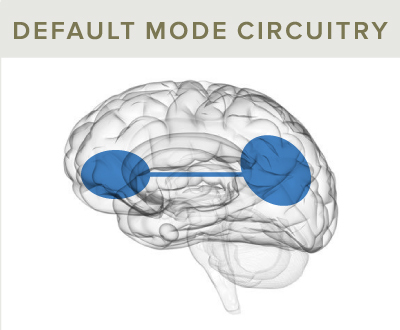
The brain’s default mode circuitry (or network) has been mapped. And while there are technical obstacles to measuring small bouts of seeking circuitry activity during mind wandering, researchers have shown connections between the default mode and seeking circuitries.
We certainly don’t need brain research to know this: when we (mindfully) observe our own daydreams, memories and plans – that is, our default mode activity – we see how much they revolve around seeking and experiencing ‘rewards’ in our imaginations. Future yummy meals, fun weekends, vacations. Future achievements, praise, vindications.
All those little reward scenarios we keep seeking and experiencing in our heads – of getting or keeping things we want, and escaping from things we don’t want or wish hadn’t already happened – all are manifestations of the default mode circuitry in action.
Executive Circuitry
Finally, the brain’s executive circuitry, which mostly consists of the prefrontal cortex, is what allows us to think, plan, solve problems, imagine the future, manage our emotions and impulses, remember our highest values and goals, and make thoughtful decisions.
The executive circuitry also allows us to direct our attention where we choose, based on our goals and plans – rather than where it’s automatically pulled by internal feelings, thoughts and images, or by external sights, sounds and other stimuli.
These are all known as ‘executive functions,’ which is why this circuitry is referred to as the executive circuitry.
This circuitry is connected to the other key circuitries described above, and it can play big roles in emotional experience and behavior, and especially in relationships.
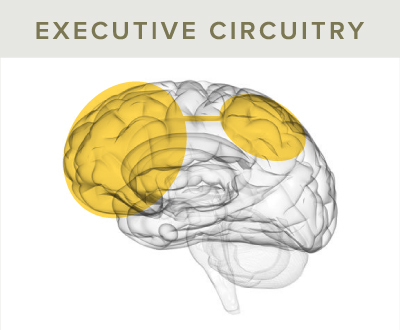
When we feel safe, and have enough support from others and enough skills of our own, we can use our prefrontal cortex to notice, reflect upon, understand, tolerate and manage painful and unwanted feelings – in ourselves and in others.
The executive functions of the prefrontal cortex can also help us to resist and overcome unhealthy habits and impulses.
Some of these executive functions are called ‘self-regulation capacities.’ Others play central roles in our capacities to attune to others and relate to them in healthy and fulfilling ways (the main focus of Dan Siegel’s interpersonal neurobiology). We need these self-regulatory executive functions to heal from the effects of hurtful and harmful past experiences, and to become free of addictions.
Importantly, we develop – and can increase – these executive (circuitry) functions primarily through our relationships with other people. For example, we first learned how to manage our fears and cravings (or not) from how our parents managed theirs (or didn’t) and how they related to our emotions and behaviors. Those and other important relationships (however healthy or unhealthy) have played big roles in determining the capacities and habits of our executive circuitry.
Unfortunately, some traumatic experiences (especially in early childhood) and some intoxicating substances can harm the executive circuitry. Fortunately, because the human brain has an amazing capacity to rewire and heal, in most cases such damage is only temporary and/or can be overcome by compensatory brain adaptations.
Most importantly, the brain’s executive circuitry can be harnessed to bring healing and happiness. We can learn and practice skills for working with our attention; for observing, accepting and transforming our feelings, thoughts and impulses; and for deliberately cultivating healthy and fulfilling habits of thinking, feeling, and behaving.
In short, we can learn to use our executive circuitry to access, harness and transform the other key circuitries of our brain, especially the seeking, satisfaction and embodiment circuitries.
Such skills may be learned and strengthened in safe and healthy relationships, in therapy or counseling, and by engaging in practices of philosophical, religious and spiritual traditions, including various forms of meditation and contemplation.
Keys to Understanding Our Suffering, Healing and Happiness
Knowing these brain circuitries, and learning from direct (especially contemplative) experience how they shape our thoughts, emotions, and behaviors – over the course of our lives, moment to moment, day to day – gives us powerful insight into how our brains work.
Although sages of the past could not teach their wisdom in terms of the brain, working with these key circuitries – to heal and redeem suffering, and to seek and embody true goods and genuine happiness – has always been at the heart of humanity’s great philosophical, religious, spiritual and contemplative traditions.
Those are topics that I address on the next page, Cycles of Suffering, Healing & Happiness.
